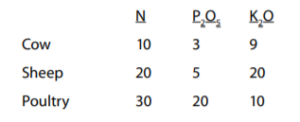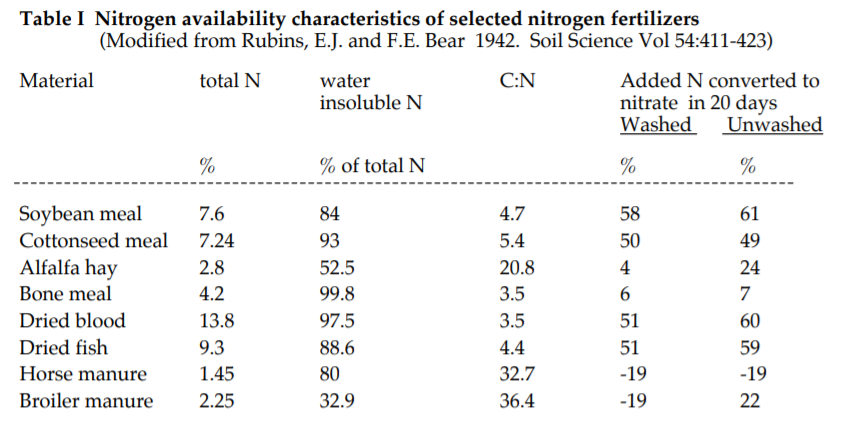by Eric Sideman, PhD
MOFGA’s Organic Crop Specialist Emeritus
There are two basic approaches to fertilization. The first is to provide required nutrients to each crop in a soluble form that plants can use immediately, i.e., feed the plant. The advantage to this approach is the opportunity to quite accurately meet a crop’s need. The disadvantage is soluble nutrients do little to build long term soil fertility.
The second approach is building and maintaining a healthy, biologically active soil with large reservoirs of plant nutrients that will provide a crop with its needs. This is the organic approach to fertility and is based upon building soil organic matter, conserving and recycling plant nutrients through cover crops and composting, providing for microbiological activity and adding slow release, natural sources of minerals. Nutrient reservoirs are built over years and then maintained for the most part with compost. The following is a list of materials used to supplement nutrient needs:
Alfalfa meal (2-1-2) A plant based nitrogen source. The nitrogen is released moderately fast.
Blood meal (12-0-0) A very quick-release form of nitrogen with some soluble N for organic growers. Used for side dressing during the growing season. If used in a potting mix the mix should sit a few weeks to avoid ammonia toxicity. Avoid direct root contact as it can burn
Bone Meal (steamed) (5-12-0, with 22% calcium) An immediately available source of phosphorus good for side dressing early in the season before biological activity gets going. Steamed bone meal has more N than precipitated bone meal, which is commonly used as a feed additive.
Compost (approx. 1-1-1) After reservoirs of nutrients have been built up using rock powders, compost is the choice source of nutrients to maintain levels. It is the best source of stable organic matter for building soil levels. The nutrients are tied up in the organic matter and released evenly over the season. Quality of compost varies greatly as do salt content (very important if using for seed starting) and maturity (important with respect to toxicity of ammonia and nitrogen lock-up).
Fish Meal (9-3-0) An excellent source of slow to moderately released N. The N is tied up in proteins so no risk of burning. The fish odor may attract animals.
Granite dust (0-0-6) Widely used to remineralize soil with micronutrients and potassium. Releases nutrients very slowly.
Greensand (0-1-7 with 3% Mg) A mined rock powder naturally containing potassium that is released over time as the mineral breaks down. Many other nutrients occur in the sand like material (Ca, Mg, Fe, and P).
Gypsum (23% calcium) The choice source of calcium when no adjustment of pH is needed. Also contains sulfur, which, as air pollution is cleaned up, may become a needed nutrient.
Kelp (1 – 5% N, 0.2 – 1.3% Phosphate, 3 – 10% potash, dry weight) In addition to macronutrients, seaweed has a variety of micronutrients, especially boron, copper, iron, manganese and molybdenum. Perhaps the most important merit of seaweed is its organic matter that breaks down quickly in soil.
Dolomitic limestone contains about 25% calcium and about 10% magnesium.
Calcitic limestone contains about 38% calcium. Calcitic is harder to find. Well stocked stores should carry it because if magnesium is not needed dolomitic limestone should not be used.
Livestock Manure Uncomposted manure offers some benefits and risks that make its use different from composted manures. It is up to the grower to decide which fits the farm system and particular situation. For example:
- Composted manure has nutrients in a stable form which are less likely to shock the system and be less susceptible to leaching.
- Contaminants such as livestock medications, weed seeds, and human pathogens are more likely to have been decomposed during composting.
- The microbial population of finished compost is very diverse.
- Manure will have more nitrogen, especially quickly available nitrogen, than compost.
The different types of manures have important characteristics that the grower must consider. For example, poultry manure contains very soluble nutrients and very little organic matter. This makes it good for a quick boost in fertility (especially P and N) but it does little to build the soil.
Average available N-P-K from farm manures (lbs/T):

Potassium sulfate (0-0-50) Potassium sulfate is available in both natural and synthetic forms and only the natural form is permitted on organic farms. Check with the supplier before purchasing. It is an inexpensive material that adds potassium to the soil without any other cations. It is very soluble and should be used only when crops are growing or it will likely be lost to leaching.
Rock phosphate (0-3-0) Rock phosphate contains about 30% phosphorus but only about 1-3% is available at any time. It is generally used to build up reservoir of phosphate. Rock phosphate has less available P than colloidal but much more total P (colloidal is about 16%). Rock is generally preferred because if you are after available P bone meal or chicken manure are better sources.
Soy bean meal (6-1-1) Seed meals are preferred sources of N for organic growers because they are the best value except for manure. The nitrogen is moderately available because of the type of proteins (faster than fish meal or bone meal, less quickly than blood meal). There is no risk of burning plants.
Sul-Po-Mag (0-0-22, with 11% Mg) This is a mined rock commonly used as a potassium source in conventional fertilizers. It is the most economical source of available potassium for organic growers. Use only if Mg is needed too. A good source of magnesium if no pH adjustment is needed. The nutrients are immediately available to plants. Only use when crop is growing.
Wood Ash (0-1-5) The potassium is quickly available and so wood ash should only be applied shortly before crop need. Wood ash has two thirds the liming power of limestone and acts very quickly.

Last published November 2007

